
The Abbey Church of Saint Peter and Saint Paul, Shrewsbury is an ancient foundation in Shrewsbury, the county town of Shropshire, England.
A royal peculiar is a Church of England parish or church exempt from the jurisdiction of the diocese and the province in which it lies, and subject to the direct jurisdiction of the monarch.
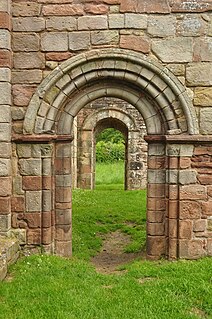
White Ladies Priory, once the Priory of St Leonard at Brewood, was an English priory of Augustinian canonesses, now in ruins, in Shropshire, in the parish of Boscobel, some eight miles (13 km) northwest of Wolverhampton, near Junction 3 of the M54 motorway. Dissolved in 1536, it became famous for its role in the escape of Charles II of England after the Battle of Worcester in 1651. The name 'White Ladies' refers to the canonesses who lived there and who wore white religious habits.
Robert of Shrewsbury was an English cleric, administrator, and judge of the Angevin period. His career culminated in his appointment as Bishop of Bangor.

Burton Abbey at Burton upon Trent in Staffordshire, England, was founded in the 7th or 9th century by St Modwen or Modwenna. It was refounded in 1003 as a Benedictine abbey by the thegn Wulfric Spott. He was known to have been buried in the abbey cloister in 1010, alongside the grave of his wife.

The Dean of Windsor is the spiritual head of the canons of St George's Chapel at Windsor Castle, England. The dean chairs meetings of the Chapter of Canons as primus inter pares. The post of Dean of Wolverhampton was assimilated to the deanery of Windsor, around 1480.
Staffordshire was a county constituency of the House of Commons of the Parliament of England then of the Parliament of Great Britain from 1707 to 1800 and of the Parliament of the United Kingdom from 1801 to 1832. It was represented by two Members of Parliament until 1832.

St Peter's Collegiate Church is located on the northern side of central Wolverhampton, England. For many centuries it was a chapel royal, and from 1480 a royal peculiar, independent of the Diocese of Lichfield and even the Province of Canterbury. The collegiate church was central to the development of the town of Wolverhampton, much of which belonged to its dean. Until the 18th century, it was the only church in Wolverhampton and the control of the college extended far into the surrounding area, with dependent chapels in several towns and villages of southern Staffordshire.

Lilleshall Abbey was an Augustinian abbey in Shropshire, England, today located 6 miles (9.7 km) north of Telford. It was founded between 1145 and 1148 and followed the austere customs and observance of the Abbey of Arrouaise in northern France. It suffered from chronic financial difficulties and narrowly escaped the Dissolution of the Lesser Monasteries in 1536, before going into voluntary dissolution in 1538.

Farewell Priory was a Benedictine nunnery near Lichfield in Staffordshire, England. Although it received considerable episcopal support, it was always small and poor. It was dissolved in 1527 as a by-product of Cardinal Wolsey's scheme to establish a college within Oxford University.
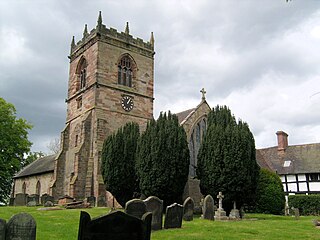
Lapley Priory was a priory in Staffordshire, England. Founded at the very end of the Anglo-Saxon period, it was an alien priory, a satellite house of the Benedictine Abbey of Saint-Remi or Saint-Rémy at Reims in Northern France. After great fluctuations in fortune, resulting from changing relations between the rulers of England and France, it was finally dissolved in 1415 and its assets transferred to the collegiate church at Tong, Shropshire.
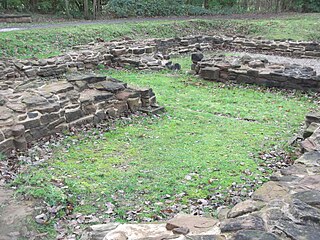
Sandwell Priory was a small medieval Benedictine monastery, near West Bromwich, then part of Staffordshire, England. It was founded in the late 12th century by a local landowner and was only modestly endowed. It had a fairly turbulent history and suffered considerably from mismanagement. It was dissolved in 1525 at the behest of Cardinal Wolsey – more than a decade before the main Dissolution of the Monasteries under Henry VIII

St Mary Magdalene's Church is in the village of Battlefield, Shropshire, England, dedicated to Jesus' companion Mary Magdalene. It was built on the site of the 1403 Battle of Shrewsbury between Henry IV and Henry "Hotspur" Percy, and was originally intended as a chantry, a place of intercession and commemoration for those killed in the fighting. It is probably built over a mass burial pit. It was originally a collegiate church staffed by a small community of chaplains whose main duty was to perform a daily liturgy for the dead. Roger Ive, the local parish priest, is generally regarded as the founder, although the church received considerable support and endowment from Henry IV.

Black Ladies Priory was a house of Benedictine nuns, located about 4 km west of Brewood in Staffordshire, on the northern edge of the hamlet of Kiddemore Green. Founded in the mid-12th century, it was a small, often struggling, house. It was dissolved in 1538, and a large house was built on the site in Tudor and Jacobean styles by the Giffard family of Chillington Hall. Much of this is incorporated in the present Black Ladies, a large, Grade II*-listed, private residence.
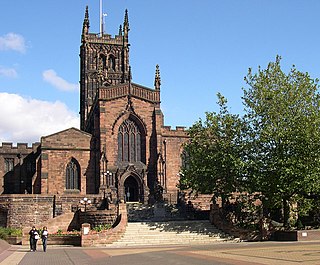
The Dean of Wolverhampton was the head of the chapter of Canons at St. Peter's Collegiate Church, Wolverhampton until the chapter was disestablished in 1846. The collegiate church was, until that point, a Royal Peculiar falling outside of the diocesan and provincial structures of the Church of England. Today, the church is district church within a team parish led by a rector, although it has its own vicar and curate within the team.
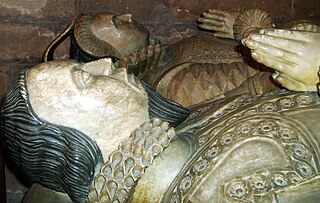
John Giffard (1534–1613) was a Staffordshire landowner and Member of the English Parliament, notable as a leader of Roman Catholic Recusancy in the reigns of Elizabeth I and James I.

St. John's Church is a Grade II* listed Church of England parish church in Wolverhampton.

St Mary's Church, Stafford is a Grade I listed parish church in the Church of England in Stafford.

The recorded abbots of Shrewsbury run from c 1087, four years after Shrewsbury Abbey's foundation, to 1540, its dissolution under Thomas Cromwell. The abbey was large and well-endowed and the abbots were often important political figures as well as ecclesiastical leaders. They varied greatly over the centuries in ethnic and social origins, intellectual attainments and holiness of life. The first two, Fulchred and Godfred, were imported from Normandy. The remainder seem to have been born in Britain and most, but not all, were elected, or at least selected, from the chapter of the abbey. As important territorial magnates, the abbots were always called to take part in the sessions of Parliament from its very beginnings as an institution in 1265. As important figures in the Western Catholic Church, abbots were permitted by the Pope to wear the pontifical ring from 1251 and the mitre from 1397.

The Collegiate Church of St Bartholomew, Tong is a 15th-century church in the village of Tong, Shropshire, England, notable for its architecture and fittings, including its fan vaulting in a side chapel, rare in Shropshire, and its numerous tombs. It was built on the site of a former parish church and was constructed as a collegiate church and chantry on the initiative of Isabel Lingen, who acquired the advowson from Shrewsbury Abbey and additional endowments through royal support. Patronage remained with the lords of the manor of Tong, who resided at nearby Tong Castle, a short distance to the south-west, and the tombs and memorials mostly represent these families, particularly the Vernons of Haddon Hall, who held the lordship for more than a century. Later patrons, mostly of landed gentry origin, added further memorials, including the Stanley Monument which is inscribed with epitaphs specially written by William Shakespeare.


















